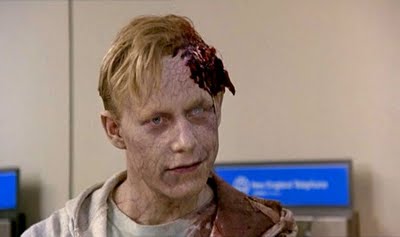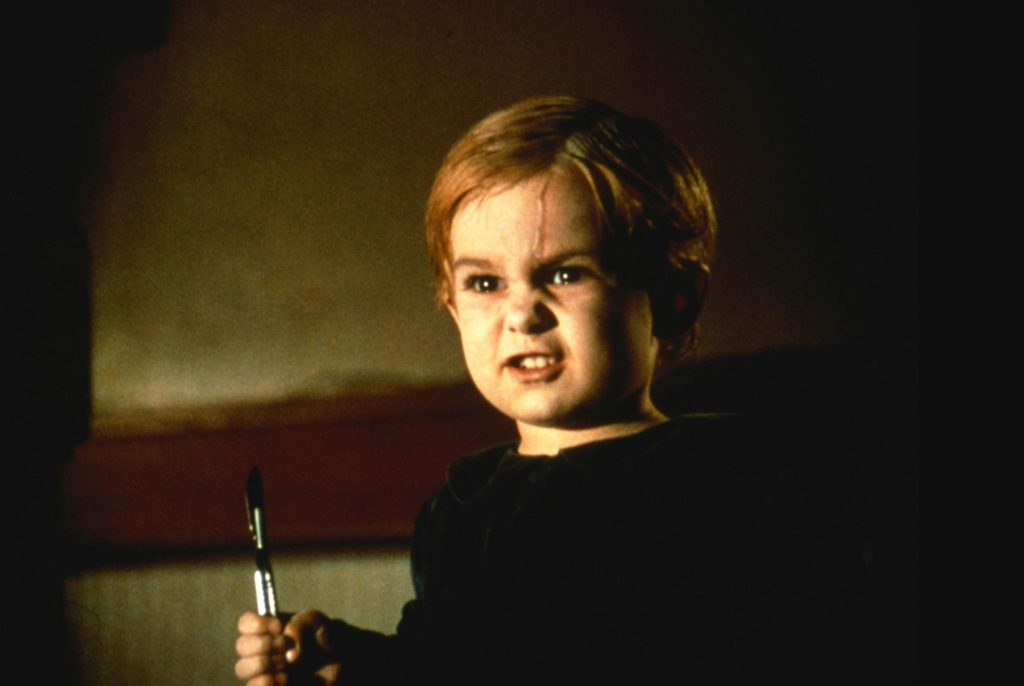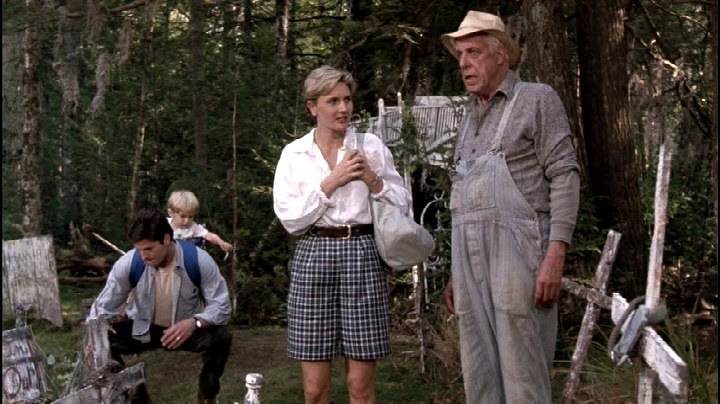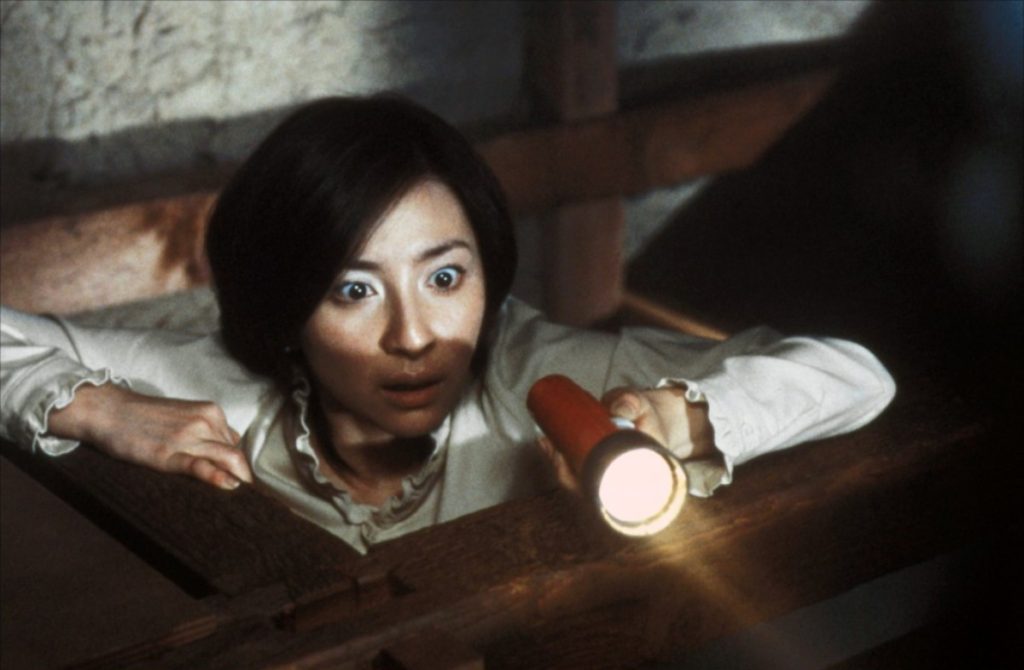
Rika, going above and beyond the call of duty for a social work volunteer.
This January, in support of the Toronto Rape Crisis Centre / Multicultural Women Against Rape, friends and family have raised over $1,000, which means I have to watch and write about thirty-one horror movies. I’ll watch (on average) one movie a night, many of them requested by donors, after which I’ll write some things about said movies on this website. Be forewarned that all such write-ups will contain spoilers! Today’s film is one of the modern classics of J-horror (or Japanese horror), Ju-On: The Grudge (2002), directed by Takashi Shimizu, who also dirtied the American remake. The film was requested by donor and friend, Carrie Macmillan, a marketing specialist at University of Toronto Press journals, and a big supporter of the TRCC/MWAR. The DVD was once again provided by my local video store, Queen Video.
What happens:
Ju-On: The Grudge was – along with The Ring, Pulse, and Dark Water – one of the first Japanese films from the early 2000s that took the horror world by storm with their fresh takes on typical haunted house tropes. In Ju-On, the opening title card defines the word for us: ju-on is the curse of one who dies in the grip of a powerful rage. This card is followed by frenetic shots of a dad-like man covered in blood, engaging in such varied actions as taping stuff together, staring at a woman’s corpse, and roughly handling a cat. Could this be the powerful rage we were hoping for?
The film is divided into several vignettes, each named after a different character, that fit together elliptically. The first introduces us to Rika Nishina (Megumi Okina), a volunteer at the social welfare centre. Her supervisor asks her to check on a client of theirs all by herself (highly unorthodox for a volunteer!), promising her dinner if she does it. She eventually agrees and makes her way to the Tokunaga household. No one answers at the door, so she lets herself in and finds an episode of Hoarders has exploded all over the inside of the home. After repeated calls, she finally sees someone’s hand press against the shoji door panel. Upon investigation, she finds it’s an old woman, Ms. Sachie (Chikako Isomura), dishevelled and in a near-cataontic state. Worse: it looks like she’s soiled her tatami mat.
Rika sets to cleaning up both Ms. Sachie and the house. In her housekeeping, she discovers a crumpled family photo in which the mother has been torn out. Then, while cleaning the second floor, she hears a scratching behind a makeshift wall, secured with tape. As she approaches the scratching, she hears a loud meow. There’s a cat behind the wall! She removes the tape and finds not only a black cat (seemingly unharmed), but a boy! And the boy looks just like the kid in the crumpled photo. Rika calls into the social welfare centre to say she’s found a boy in the house, but his parents have yet to arrive. Shortly thereafter, a woman named Hitomi calls the family and leaves a message on the answering machine. Ms. Sachie can’t tell her who the boy is (obvi), but the boy says his name is Toshio. Moments later, Ms. Sachie starts mumbling to herself – something about “I told her over and over” – then her face goes rigid with terror and Rika suddenly sees what she sees: a black spectre looming over top her face. Rika passes out.
The film cuts to a young couple in the same house, Katsuya (Kanji Tsuda) and Kazumi Tokunaga (Shuri Matsuda), arguing about his elderly mother. The wife, Kazumi, complains his mother is keeping her awake with her strange sounds, but the husband hears nothing. They’re paying for a social worker who is apparently no help. When Katsuya leaves for work, Kazumi finds herself stalked through her own house by a mysterious child (Toshio, though he looks way more ghostly now) and his cat. Eventually, she sees them and screams in terror. Katsuya arrives home later and can’t find his wife. He calls for her and eventually finds her, seemingly catatonic on the bed. Katsuya calls for an ambulance when the ghost kid suddenly pops up beside the bed and yowls just like an angry cat. Kazumi, on the bed, starts to gasp (and maybe dies?), while Katsuya nervously bites his nails, then turns dark, as if possessed.
Hitomi Tokunaga (Misaki Ito), Katsuya’s sister, then arrives downstairs, wondering where her brother and sister-in-law have gone. She finds Katsuya shaking on the stairs. He insists she leave, forcing her out the door and ranting that “that’s not my child.” Katsuya shoves her out of his house so quickly, her shoes are still unstrapped. He goes upstairs, possessed, and we see a spooky woman peering out from window above.
I’m still not sure this is worse than bedbugs.
The film switches perspective again, focusing on Hitomi, Katsuya’s sister, in the middle of making the telephone call we heard the other end of during the first segment. What we didn’t see is Hitomi receiving a return call while she’s in a bathroom stall at work. Instead of her brother, she only hears a long, droning guttural sound. The sound continues after she hangs up and exits the bathroom. A raggedy teddy bear is tossed on the bathroom floor and a black spectre (for lack of a better description) begins to emerge from one stall over. Hitomi rushes back to her office and summons a security guard.
The security guard leaves to investigate the women’s washroom. Hitomi watches him via the security camera, and is witness to a black mist that begins to envelop him and pull him inside. Hitomi freaks right out and runs all the way home, stalked by the ghost child – unseen by her but visible to the audience. Once at her apartment, she receives another phone call from her brother, who claims to be outside. He just needs her unit number. Moments later, Hitomi sees him on the other side of her peephole, but when she opens the door to greet him, no one is there. Instead, she hears the low, guttural sound from her telephone again. Hitomi hides in her bed and turns on the television to distract herself, but the pictures begin to distort and make strange sounds, as well. She turns off the TV and ducks under the covers, but who should she find, nestled against her tummy, but a ghostly demon-woman!
Eventually, Rika’s supervisor goes to check on the house. He finds the old woman still clutching her face and Rika curled up in the fetal position in a corner. Before long, the police are on the scene. Our detectives Nakagawa (Hirokazu Inoue) – an older, moustachioed man – and Igarashi (Daisuke Honda) – a young, James Dean type – scour the house for evidence of what happened. They hear a cellular phone ring inside the house, but can’t place where it’s coming from. Eventually they find the Tokunagas dead in the attic, phone in Katsuya’s front pocket. Detective Nakagawa interviews Rika once she’s recovered from her trauma. She tells him about the boy, Toshio, and the detective regrets to inform her the Tokunagas had no children. Meanwhile, Detective Handsome has been doing some research on the house, and it seems many families who’ve lived there have gone missing. Years ago, a man named Takeo Saeki killed his wife, Kayako (Takako Fuji) in that very house. Takeo was later found dead at the roadside. They had one son: Toshio. Dun-dun-DUNNN!
Fun fact: Kayako’s body was also found in the attic. (Okay, I guess that’s not fun.) Additionally, only one police officer working on the Kayako Saeki murder investigation is still kicking around, so the young cop pays him a visit. Yuji Toyoma (Yoji Tanaka) is no longer a cop and is primarily working as a devoted dad to one daughter, Izumi, when the detective finds him. He looks like someone’s walked over his grave when the detective asks about the Saeki case. Around this same time, someone finds Rika’s supervisor, dead of fright in a bathroom.
Yuji accompanies the detective to look at the security footage from Hitomi’s office. While Igarashi takes a phone call, Yuji watches the full security camera tape. A truly horrific black figure leaves the restroom after killing the security guard and approaches the camera, eventually enveloping it entirely in black. Suddenly eyes can be seen in the blackness, and Yuji (and we audience members) nearly pees his pants in terror. Across town, Rika awakes in her bed to find ghost Toshio leaning over the bed. The ghostly wife, Kayako, looms over the headboard making her usual guttural sounds.
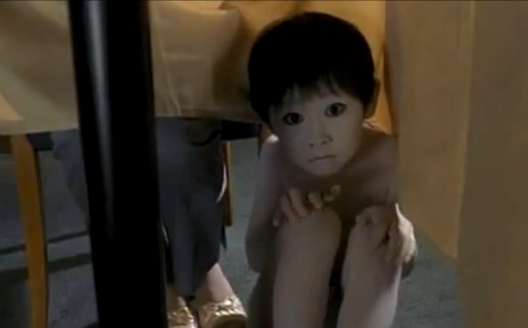
“The hottest new spot in town is Ju-On: they have sixty wines, ghost children … everything!”
Yuji Toyoma, sick and tired of these motherf–ing grudges in this motherf–ing house, breaks the police tape and shows up at the Tokunagas one night with two containers of gasoline. He starts drowning the place in petrol when he hears teenaged girls talking from behind the door. It opens slightly, and a sunlight-dappled scene emerges from the other side. A teenaged schoolgirl named Izumi (just like his daughter) abandons her friends, saying she’s scared. She turns to stare at Yuji for a moment, then leaves. Yuji continues up the stairs, finds three other schoolgirls talking, who then scream out in terror. Ghost Kayako then emerges at the top of the stairs, crawling on her hands and knees and making the most horrible sounds.
Yuji topples downs the stairs, completely spooked. The detectives arrive on the scene and Yuji makes a hasty retreat. The two detectives then see what had him so scared, and the crawling monster comes after them.
The scene moves forward several years. Izumi Toyoma (Misa Uehara), Yuji’s daughter, is now a teenager (and the audience realizes Yuji was witnessing a vision from the future). Izumi and her friends, Chiharu and Miyuki, walk to school, and Izumi is distracted by a flyer for three missing teenaged friends. Later, at home, she watches a newscast that announces the body of Rika Nishina has been found in the attic of a house. Izumi’s friends show up at her apartment to show her some photos for the school yearbook, and Izumi’s very spooky mom, who looks like she hasn’t slept since the first Ju-On victim died, answers the door. They find Izumi squatting in the dark, completely terrified. When Chiharu goes to open the curtains, Izumi flips out on her. The windows have been completely blacked out with old newspaper.
Izumi then reveals that she was with the three girls when they went missing. They all visited a haunted house, but Izumi was so scared, she fled from the house on her own. Now she’s feels stalked by invisible forces. As Izumi’s friends decide to leave Izumi with her own dark thoughts, the mother approaches them and mentions Izumi is a lot like her husband was before he died. He also sealed all the windows. Chiharu and Miyuki realize they forgot to show Izumi the photographs. They pull them from the folder and notice the eyes of Izumi and the three missing girls have been completely blacked out in every image.
Back in her room, Izumi has a vision of her deceased father, looking tired. She then realizes she saw him when she was leaving the haunted house – it was some sort of ghost time portal, I guess. But that night, the missing girls return to Izumi as ghosts. They enter her room through the holes in the newspapered windows. The Night of the Living Dead Japanese Schoolgirls pursue her into the kitchen and corner her against a dumb waiter, from which emerges Kayako, who presumably drags her into hell.
Back to the past: Rika is still alive. She’s got a kicky new haircut and is back to her usual routine, caring for the old and infirm. But all is not as well as her hairdo might have you believe. In the shower, she feels someone else’s hands in that very same hair. While talking with her schoolteacher friend Mariko in a restaurant, she feels a cat run across her feet. When she looks under the table, she sees ghost Toshio, crouched at her feet! The next day, Mariko calls from the house of a boy who was absent from school. The boy is there, but his parents are missing. At the other end of the line, Rika hears a yowling cat and realizes which house Mariko is inside.
Rika runs to the house to save Mariko, but by the time she arrives, Mariko is already being sucked up into the attic by an unseen demonic force. Then the noisy, crawling Kayako comes for her down the stairs. Kayako is covered in blood as she descends toward the panicking Rika. But the longer Rika stares, the more human Kayako begins to appear. And eventually, she becomes no threat at all. But then who should arrive but the ghost of Kayako’s husband, Taeko Saeki, also covered in blood. (They had that in common.) He trods down the stairs and moves his bloody hand toward Rika’s face as she screams. The final shot of the film is Rika covered in a bloody sheet in the house’s attic. Her eyes bolt open as the camera zooms in and a guttural sound spills out from her mouth.
This is just one of the reasons I don’t trust chiropractors.
Takeaway points:
- Ju-On is all about sound design. Even if you watched this movie with your eyes closed, I’m convinced you’d have nightmares. The guttural drone that ghost Kayako makes, as well as the crackling sound that accompanies her as she jerkily crawls down the house’s stairs are two of the more unsettling sound effects in film history. The sound design reminded me a lot of Australian horror film The Babadook, another horror movie that relies heavily on truly disturbing audio.
- One of the more interesting things about Ju-On is its elliptical structure. There are so few horror movies that play with film sequence. Sure, most have a flashback here or there, but rarely does a narrative jump backward and forward in time, with only a few visual cues to give audiences a sense of where the are. It’s unfortunate more don’t use this method, as it keeps audiences uneasy and uncertain of where they are. There’s a quotation I can’t entirely remember made by a film critic about Wes Craven and his movie Last House in the Left– something about being in the director’s hands and not trusting where he’ll guide him. That’s a bit how I felt here.
- Maybe Ju-On is just a good haunted house story. But maybe it’s something else. What struck me is the conversation between Izumi’s mother and her school friends, when the mother remarks that Izumi is acting just like her father before he died. (We can assume he died of ghost-related complications.) This, and the entirety of the plot, led me to believe Ju-On is about transgenerational trauma. Not only does it serve as a metaphor of how abuse can continue from generation to generation – just look at the effect Takeo’s murder of his wife had on little Toshio – but so can trauma. Everyone who comes in contact with the house lives the rest of their life haunted until they die. It travels from parent to child, from friend to friend. This phenomenon has been seen in the children of Holocaust survivors, the children of former slaves, the children of residential school survivors: people traumatized through some family or cultural connection though they were never first-hand victims. Could Ju-Onbe the first great ghost story about transgenerational trauma?
- The film also serves as an indictment of the practice of unpaid interns. Rika is a volunteer – not even been paid for her work at the social welfare centre – but is expected to pay a visit to the creepiest haunted house in town. I assume the reason she agrees is because it will reflect well on her, make her seem like a team player, so she may one day get paying social work. Like a magazine intern copyediting in the wee hours of a Friday, Rika pays the price for her not-quite-employers’ unwillingness to pay for her labour. The message is pretty clear: internships = death.
Truly terrifying or truly terrible?: I was already terrified by the DVD menu, so Ju-On was off to an excellent start. The appearances of both Toshio and the more terrifying Kayako have diminishing returns, but Kayako’s guttural sounds are chill-inducing. And I don’t think I can un-see that security camera footage. That thirty seconds of film was scarier than all of Paranormal Activity combined.
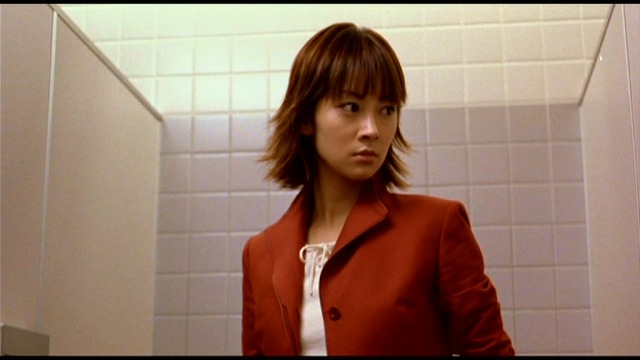
Hitomi, looking sharp.
Best outfit: Hitomi Tokunaga has the best style in Ju-On by a country mile. The outfit she wears on the day of her death – a red jacket, interestingly collared blouse, and white skirt with a diagonal red plaid – is so good, it’s almost worth being found dead in it.
Best line: “Izumi, were you paranormal?” – Chiharu to her haunted friend
Best kill: Most of the victims in Ju-On seem to die of fright or of having their souls dragged to hell or something vague like that. Which makes for very poetic, but not totally rad kills. Still, Kayako emerging from behind Izumi’s head to pull her head back to her doom was really spooky. And you can’t beat the terror of finding a ghost nuzzled against your abdomen in bed, can you?
Unexpected cameo: I honestly don’t watch enough Japanese film to recognize any actors from any of their non-Ju-On / Grudge films, but I did note that Kanji Tsuda, who plays Katsuya Tokunaga, also plays Ryuhei’s fellow downsized coworker Kurosu in the very good Tokyo Sonata.
Unexpected lesson(s) learned: yellowing newspaper over the windows can block most ghosts. As long as the seal is tight.
Most suitable band name derived from the movie: Tokunaga House.
Next up: Borgman (2013).
